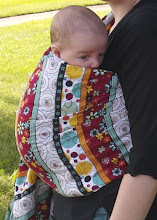- Stay aware of your environment. Watch for tripping hazards and dangerous items that baby may reach out and grab.
- Allow more space for maneuvering to avoid bumping into doorways, etc. (This is especially important when using the safety hip carry. Trust me, I know)
- Make sure that your baby's airway is not blocked by fabric or the position of his or her head.
- Certain activities may not be safe while wearing your baby. For instance, when using a knife, cooking over a hot stove or when eating or drinking something hot.
- To prevent a sore back make sure the sling is spread out wide across you shoulder and back. This will distribute the weight. When bending over always bend at the knees and keep at least one hand on baby.
- Babywearing takes practice. Keep one hand on your baby until you feel secure. You may need to take baby out, readjust and start over if you are uncomfortable.
Links
Monday, September 8, 2008
Babywearing Safety
Benefits of Babywearing
Babywearing may seem like a new fad but it's been practiced for centuries. All over the world, mothers are using shawls, scarves, and long cloths to carry their babies. In fact, in Bali, babies are carried for the first 6 months of their lives. They literally don't touch the ground until their ground-touching ceremony is held. Babywearing declined in the Western World due to the misconception that babies will be spoiled by so much attention.
The Benefits
References:
The Baby Book by William Sears, M.D and Martha Sears, R.N.
Wikipedia, http://en.wikipedia.org/wiki/Babywearing)
The Benefits
-- Babywearing organizes and regulates the baby. Dr. Sears suggests that, "It's easier to understand babywearing when you think of baby's gestation as lasting 18 months -- 9 months in the womb and at least 9 more months outside. By extending the womb experience, the babywearing (parent) provide an external regulating system that balances the irregular and disorganized tendencies of the baby."
-- Babywearing reduces crying and colic. Dr. Sears says, "Babywearing reduces crying by it's organizing effect on the baby's vestibular system... Vestibular stimulation (rocking for example) has been shown by long experience and detailed research to be the best crying stopper. Vestibular stimulation occurs during babywearing, allowing baby to click into the familiar experiences that were imprinted upon his developing mind during life inside the womb. The familiar overcomes the unfamiliar to which he is now exposed. This lessens baby's anxiety and lessens the need to fuss."
-- Babywearing enhances learning. Babies spend less time crying and in a state of quiet alertness. During this time parents have more opportunity to interact with their baby. Babies are more involved. Dr. Sears states, "Baby sees what mother or father sees, hears what they hear, and in some ways feels what they feel. Proximity increases interaction, and baby can be constantly learning... Baby learns much in the arms of a busy person."
The following is taken directly from wikipedia:
- Mothers' progesterone (mothering hormone) is increased through physical contact with the infant, leading to a more intimate maternal bond, easier breastfeeding and better care, thus lowering the incidence of postpartum depression and psychosomatic illness[citation needed].
- Infants who are carried are calmer because all of their primal/survival needs are met. The caregiver can be seen, heard, smelled, touched, tasted, provide feeding and the motion necessary for continuing neural development, gastrointestinal and respiratory health and to establish balance (inner ear development) and muscle tone is constant.[1]
- Infants are more organized. Parental rhythms (walking, heartbeat, etc.) have balancing and soothing effects on infants.
- Infants are "humanized" earlier by developing socially. Babies are closer to people and can study facial expressions, learn languages faster and be familiar with body language.[2]
- Contrary to western cultural myths, independence is established earlier.[1]
- Attachment between child and caregiver is more secure.[3]
- Decreases risk of positional plagiocephaly ("flat head syndrome") caused by extended time spent in a car seat and by sleeping on the back. Sleeping on the back is recommended to decrease the risk of SIDS. Cranial distortion resulting from non-vehicular time in car seats has shown to be more severe than in children who develop plagiocephaly from back-lying on a mattress. [4] Concern over plagiocephaly has also led the American Academy of Pediatrics to recommend that infants “should spend minimal time in car seats (when not a passenger in a vehicle) or other seating that maintains supine positioning. [5] None of the babywearing positions require infants to lie supine while being carried. Infants can even be worn while they sleep, also decreasing sleeping time spent in a supine position.
References:
The Baby Book by William Sears, M.D and Martha Sears, R.N.
Wikipedia, http://en.wikipedia.org/wiki/Babywearing)
Subscribe to:
Comments (Atom)





